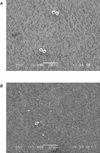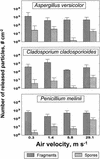Fungal fragments as indoor air biocontaminants
- PMID: 12089037
- PMCID: PMC126767
- DOI: 10.1128/AEM.68.7.3522-3531.2002
Fungal fragments as indoor air biocontaminants
Abstract
The aerosolization process of fungal propagules of three species (Aspergillus versicolor, Penicillium melinii, and Cladosporium cladosporioides) was studied by using a newly designed and constructed aerosolization chamber. We discovered that fungal fragments are aerosolized simultaneously with spores from contaminated agar and ceiling tile surfaces. Concentration measurements with an optical particle counter showed that the fragments are released in higher numbers (up to 320 times) than the spores. The release of fungal propagules varied depending on the fungal species, the air velocity above the contaminated surface, and the texture and vibration of the contaminated material. In contrast to spores, the release of fragments from smooth surfaces was not affected by air velocity, indicating a different release mechanism. Correlation analysis showed that the number of released fragments cannot be predicted on the basis of the number of spores. Enzyme-linked immunosorbent assays with monoclonal antibodies produced against Aspergillus and Penicillium fungal species showed that fragments and spores share common antigens, which not only confirmed the fungal origin of the fragments but also established their potential biological relevance. The considerable immunological reactivity, the high number, and the small particle size of the fungal fragments may contribute to human health effects that have been detected in buildings with mold problems but had no scientific explanation until now. This study suggests that future fungal spore investigations in buildings with mold problems should include the quantitation of fungal fragments.
Figures





References
-
- Aizenberg, V., T. Reponen, S. A. Grinshpun, and K. Willeke. 2000. Performance of Air-O-Cell, Burkard, and Button samplers for total enumeration of airborne spores. Am. Ind. Hyg. Assoc. J. 61:855-864. - PubMed
-
- Aukrust, L., S. M. Borch, and R. Einarsson. 1985. Mold allergy—spores and mycelium as allergen sources. Allergy 40:43-48. - PubMed
-
- Brunekreef, B. 1992. Damp housing and adult respiratory symptoms. Allergy 47:498-502. - PubMed
-
- Burge, H. A., and H. M. Ammann. 1999. Fungal toxins and β-(1→3)-d-glucans, p. 24.1-24.13. In J. Macher (ed.), Bioaerosols: assessment and control. American Conference of Governmental Industrial Hygienists, Cincinnati, Ohio.
-
- Burr, M. L., J. Mullins, T. G. Merret, and N. C. H. Stott. 1985. Asthma and indoor mould exposure. Thorax 40:688.. - PubMed
MeSH terms
LinkOut - more resources
Full Text Sources
Other Literature Sources
Medical

